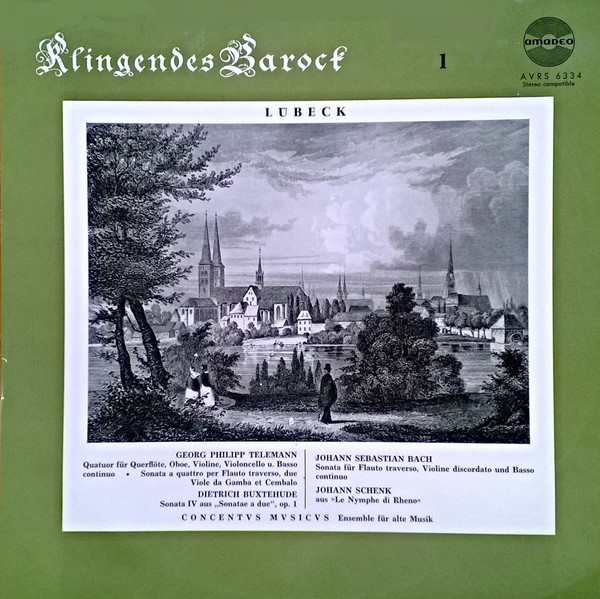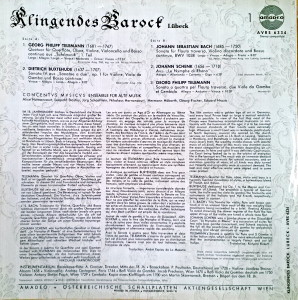 |
1 LP -
Amadeo AVRS 6334
|
 |
|
| LÜBECK -
Klingendes Barock - 1 |
|
|
|
|
|
| Georg Philipp
Telemann (1681-1767) |
|
|
| Quatuor für
querflöte, Oboe, Violine,
Violoncello und Basso continuo
aus "Tafelmusik", 1. Teil |
15' 24" |
A1 |
| - Largo/Allegro/Largo
- Vivace/Moderato - Grave/Vivace |
|
|
|
|
|
Dietrich
Buxtehude (1637-1707)
|
|
|
| Sonata IV für
Violine, Viola da Gamba und Basso
aus "Sonatae a due", op. 1 |
8' 02" |
A2 |
| -
Vivace - Allegro - Lento -
Allegro |
|
|
|
|
|
Johann Sebastian
Bach (1685-1750)
|
|
|
| Sonata für Flauto
traverso, Violino discordato und
Basso continuo, BWV 1038 |
8' 02" |
B1 |
| - Largo - Vivace
- Adagio - Presto |
|
|
|
|
|
Johann Schenk
(1656-1710)
|
|
|
| - aus "Le Nymphe
di Rheno" |
6' 20" |
B2 |
|
|
|
Georg Philipp
Telemann
|
|
|
| Sonata a quattro
per Flauto traverso, due Viole da
Gamba et Cembalo |
10' 28" |
B3 |
| - Allegro -
Andante - Vivace |
|
|
|
|
|
| CONCENTVS MVSICVS
ENSEMBLE FÜR ALTE MUSIK |
INSTRUMENTARIUM: |
|
| - Alice Harnoncourt |
Barockquerflöte: A.
Grenser, Dresden, Mitte des 18. Jh. |
|
| - Leopold Stastny |
Barockoboe: P.
Paulhahn, Deutschland um 1720 |
|
| - Jürg Schaeftlein |
Violine: Jacobus
Stainer, Absam 1658 |
|
| - Nikolaus
Harnoncourt |
Violoncello: Andrea
Castagneri, Paris 1744 |
|
| - Hermann Höbarth |
Baß Viola da Gamba:
Jacob Precheisn, Wien 1670 |
|
- Georg Fischer
|
Baß Viola da Gamba:
deutsch um 1750 |
|
| - Eduard Hruza |
Violone: Antony
Stefan Posch, Wien 1729 |
|
|
Cembalo: Kopie eines
Kielflügels um 1700 von Martin
Skowroneck, Bremen |
|
|
Bögen aus dem 18.
Jh. |
|
|
|
|
|
Luogo
e data di registrazione |
|
- |
|
|
Registrazione:
live / studio |
|
studio |
|
|
Edizione LP |
|
AMADEO
- AVRS 6334 - (1 lp) - durata 48'
16" - (p) 1966 - Analogico |
|
|
Altre edizioni
LP |
|
AMADEO
- AVRS 6334 - (1 lp) - (Edizione
francese Costallat, Paris)
|
|
|
Prima Edizione
CD |
|
- |
|
|
Note |
|
Stereo
compatibile
|
|
|
|
|
The 18th
century was a golden age of
art in Germany and every
local Prince kept as large a
musical establishment as
possible. In view of the
fact that most of the
Princes were themselves
accomplished musicians (in
conformity with the humanism
of the age) it is to be
assumed that musical
standards at their Courts
were extremely high.
Wherever a small Court was
in residence, particularly
in North Germany, musical
life centred on the church
services, on Cantors such as
J. S. Bach in Leipzig,
Telemann in Hamburg, and
Buxtehude in Lübeck,
who also provided
music-lovers from the
wealthy middle-classes with
secular music of all kinds.
Most of this music was
chamber-music, the exact
composition of the ensemble
depending on circumstances.
In form and spirit it was
definitely Court music, the
Court being looked up to as
the arbiter of everyday life
in the baroque era. The
result was an immense demand
for virtuoso chamber-music
for special occasions, and
an enormous quantity of
music of all kinds was duly
turned out. Novelty and
originality were in constant
demand. The best and most
effective works were copied
and in some cases
printed.
TELEMANN's
Quartet for flute, oboe,
violin and bass is a
typically German
miscellany of styles, a
harmonious blend of
French and Italian.
BUXTEHUDE
dedicated his Op. 1 to
the Mayor and
Corporation of Lübeck.
The ensemble is
typical of German
taste, the violin and
the viola da gamba,
the favourite solo
instruments of the
Italians and the
French respectively
being used in concert.
J.
S. BACH's Trio
Sonata for violin,
flute and basso
continuo is in an
unusual form each of
the two weighty slow
movements being
succeeded by a
brief, fleeting
Allegro. To avoid
drowning the slower
register of the
flute the two upper
strings of the
violin are tuned a
whole tone flat.
JOHANN
SCHENK was a gamba
player at the Düsseldorf
Court. "Le Nymphe
di Rheno" is a
succession of
suites for two
solo bass gambe
concertanti, and
Schenk exploits to
the full all the
possibilities of
the gamba by
polyphonic
chording and
abrupt contrasts
of register.
TELEMANN's
Sonata a quattro
for flute and 2
Gambe
is in the
Italian style,
which is all
the more
remarkable
seeing that
the
instrumentation
is largely
French and not
all Italian.
Nikolaus
Harnoncourt
(Translation:
Richard
Rickett)
|
|

